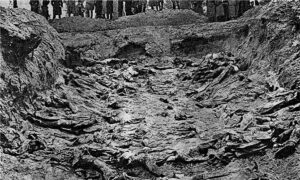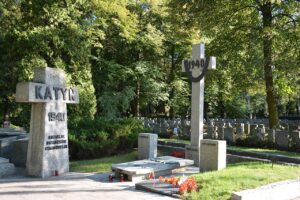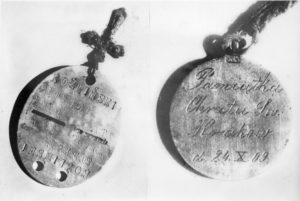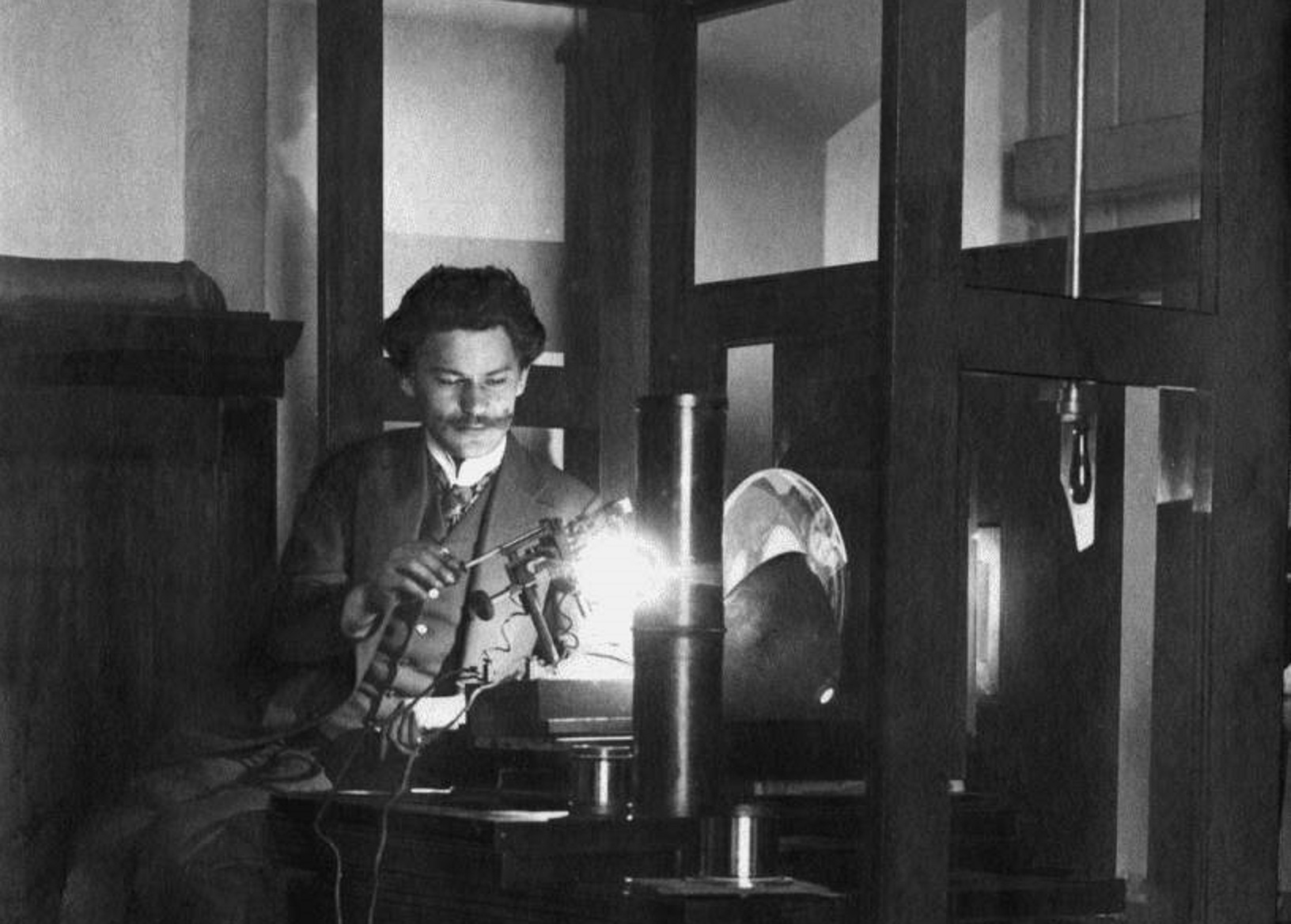Recalling the Katyn Massacre was an important aspect of the activities of the democratic opposition in the Polish People’s Republic (PRL), one of the reasons being the subject’s high importance for society back then.
by Grzegorz Majchrzak
This is best exemplified by the fact that a booklet by Ryszard Zieliński entitled ‘Katyń’ was the most-published material outside of the censorship system (underground). It was typically issued under the names of the first and last victims from the Katyn list, Jan Abramski and Ryszard Żywiecki. It was originally published in 1977 and over twelve years there were as many as 32 editions in total.
‘On 13 April, the fortieth anniversary of a tragedy effectively erased from Poland’s history is going to be commemorated. It concerns the murdering of 4,500 Polish officers in the Katyn Forest. Responsible for that act are the then authorities of the Soviet Union,’ one could read in a 1980 occasional written statement of the Movement for Defence of Human and Civic Rights (ROPCiO). Incidentally, opposition activists declared 1980 Year of Katyn and 13 April 1980 a day of national mourning, to be expressed by wearing black armbands. Apart from the ROPCIO, similar statements were issued by a range of independent organisations. For example, in one signed by the Workers’ Defence Committee one can read: ‘Together with the entire Polish nation, together with all the people in the world for whom a crime is a crime – regardless of who the perpetrator is – we demand that those guilty of it be disclosed and punished. We demand that not seeking revenge, which we reject, but in the name of justice and truth.’ In ‘Uczeń Polski’, a periodical published in 1979-1989 by Warsaw secondary school pupils, the demand was expressed in a straightforward fashion: ‘Let us demand the truth about Katyn!’

Appeals, statements and occasional articles were not all and anniversary commemorative events – obviously illegal – were held, too, despite decisive steps taken by the PRL authorities, mainly the communist Security Service (SB), which confiscated more than 8,000 related prints – in Gdansk, Krakow, Lublin, Lodz, Warsaw and elsewhere. 72 persons were apprehended during those events. Additionally, activists of the Committee for National Self-Determination (KPSN) were involved in an interesting and original initiative: on 27 April 1980, they wrote a letter to the United Nations demanding the establishment of an international commission to explain the Katyn case.
The Katyn case had also its Olympic aspect. On19 July–3 August 1980, the Olympic Games were held in Moscow, which in the context of the Soviet invasion of Afghanistan in December 1979 was highly controversial and protested against in the international arena. In the case of Poland, there was an additional weight to it, namely the memory of Soviet crimes, especially that of Katyn. No wonder then that there appeared appeals and leaflets calling for a boycott of the Moscow Olympics. The loudest one – thanks to its being read out on Radio Free Europe – was an appeal of the KPSN of 13 February 1980 to Polish Olympians. It was issued as the Winter Olympics were starting in Lake Placid yet concerned the summer Games to be held in the Soviet capital. One could read there as follows: ‘The summer Olympics are to be held in July 1980 in Moscow – the capital of the country where 40 years ago a crime of genocide was committed on around 15,000 Polish officers held captive by Russian troops, which together with the German army invaded Poland in September 1939. The Committee for National Self-Determination has proclaimed 1980 ‘Year of National Remembrance’ and demands that the government of the Soviet Union disclose the perpetrators and circumstances of the Katyn Massacre as well as locate all burial sites of Polish citizens murdered in the USSR.’ And further: ‘In our statement of 31 January, we opposed the most recent invasion of Afghanistan by Russian troops. Given the circumstances, the participation of Polish Olympians in the Moscow Games should be considered contrary to the dignity of the Nation which for two centuries has been fighting for its Independence and bleeding profusely for “your freedom and ours”.’

Obviously, the Katyn Massacre featured in activities carried out by the opposition before 1980. Indeed, it was present from the its beginning and soon became an important aspect of its operation. This is evidenced by the establishment of two independent organisations that focused exclusively, or mainly, on Katyn: the Katyn Institute in Poland operating in Krakow and the Warsaw-based Katyn Committee. The former was set up in the spring of 1978 by Adam Macedoński, Andrzej Kostrzewski and Stanisław Tor. For the first several months (until April 1979), it operated in a clandestine manner and later openly.
It published ‘Biuletyn Katyński’ (1979-1981) and translated foreign-language (mainly western) publications about Katyn (e.g. the Report of the United States House Select Committee to Conduct an Investigation of the Facts, Evidence, and Circumstances of the Katyn Forest Massacre). The Katyn Committee, in turn, was established in September 1979 (as the Clandestine Katyn Committee) on the initiative of Fr Antoni Czajkowski, Fr Wacław Karłowicz, brothers Andrzej, Arkadiusz, Sławomir and Stefan Melak as well as Jan Waś. Its objective was to commemorate the victims of the Katyn Massacre and uphold the memory of the Poles murdered in the East.
Katyn, however, concerns not just individual underground organisations or an aspect of activities performed by other opposition actors but also memorial sites, or sites where the murdered were commemorated. Certainly, the best-known one was the’ Katyn Valley’ at the Powązki Military Cemetery in Warsaw, where independent commemorative events were staged both in the 1970s and the 1980s. The first patriotic and religious event took place there in 1974 and was organised by Fr Wacław Karłowicz and Stefan Melak. In the years to come, it was also the venue for commemorating anniversaries which the communist authorities did not recognise, such as the anniversary of the Soviet Union’s invasion of Poland (17 September), the 1920 Battle of Warsaw or the proclamation of the Constitution of 3 May and regaining of state independence (11 November). All that under the watchful eye of Security Service officials, as evidenced, for instance, by film footage they recorded entitled Dolinka Katyńska [The Katyn Valley], documenting the course of the commemorative event held there on 31 August 1988. It was also there that wooden and steel crosses were placed bearing the names of the officers murdered in Katyn, then meticulously removed by ‘unknown perpetrators’. Initially, such commemorative actions were spontaneous and later (from 1978 onwards) also involving opposition activists like the ROPCiO co-founder Wojciech Ziembiński. In 1979, a wooden cross bearing the symbol of Fighting Poland (the Kotwica) and an inscription about the murdered (with a shot at the back of the head) in the ‘inhuman land’ was put there by activists of the Katyn Committee.


The imposition of martial law in the night from 12 to 13 December 1981 necessitated other forms of commemorating the Katyn Massacre. The truth went underground once again. Knowledge about Katyn was disseminated during presentations in private households and churches, Church-led itinerant pilgrimages, anniversary masses (e.g. in the Holy Cross Church in Warsaw) or scouting camps. Such initiatives were successful despite counteraction on the part of the SB, trying to stifle even the delivery of occasional religious services. Such actions were still taken after the Round Table talks. For instance, on 12 April 1989 officials interviewed the parish priest at Wawel Cathedral because of a holy mass planned by the Confederation of Independent Poland for ‘those murdered in Katyn’. They even managed to get his promise that there would be a service held, but – as each month – for Pope John Paul II, with a sermon ‘on papal themes’. The first completely unrestricted commemorative event was possible only a year later, on the 50th anniversary of the Katyn Massacre.
Author: Grzegorz Majchrzak – works at the Historical Research Office of the Institute of National Remembrance.
Translation: Alicja Rose & Jessica Sirotin





